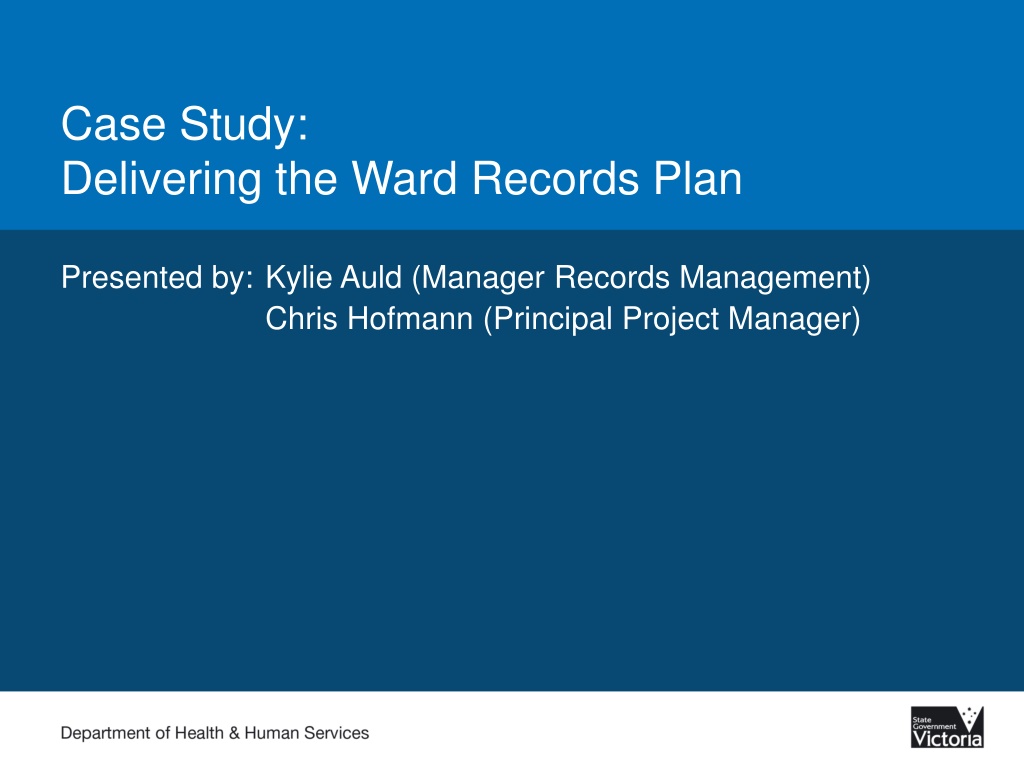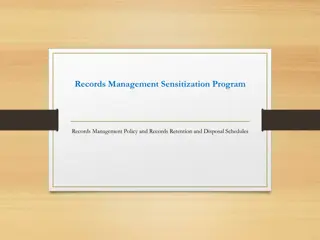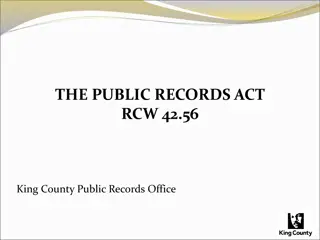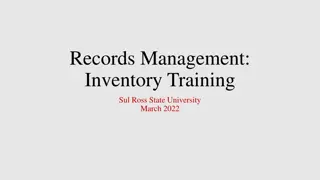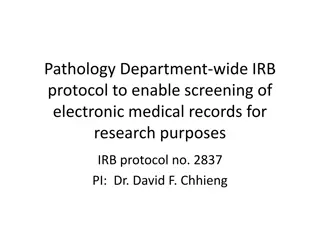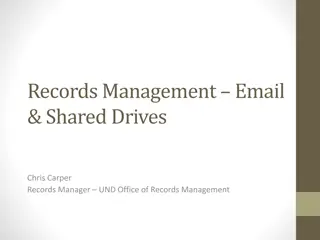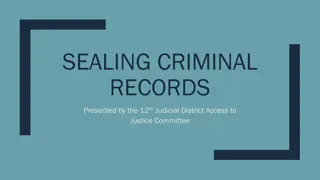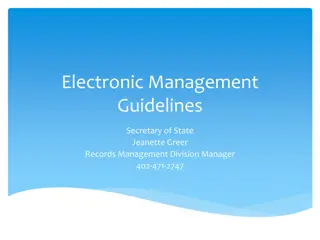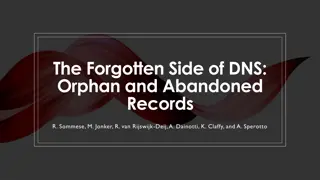Delivering the Ward Records Plan: A Case Study
Developing a comprehensive plan to address the storage and management of ward records is crucial for providing individuals with access to their personal histories and fostering healing from past traumas. This case study delves into the challenges faced, key recommendations made by the Ombudsman, and the proposed strategies for delivering the Ward Records Project effectively.
Download Presentation

Please find below an Image/Link to download the presentation.
The content on the website is provided AS IS for your information and personal use only. It may not be sold, licensed, or shared on other websites without obtaining consent from the author.If you encounter any issues during the download, it is possible that the publisher has removed the file from their server.
You are allowed to download the files provided on this website for personal or commercial use, subject to the condition that they are used lawfully. All files are the property of their respective owners.
The content on the website is provided AS IS for your information and personal use only. It may not be sold, licensed, or shared on other websites without obtaining consent from the author.
E N D
Presentation Transcript
Case Study: Delivering the Ward Records Plan Presented by: Kylie Auld (Manager Records Management) Chris Hofmann (Principal Project Manager)
Session Overview Developing the Ward Records Plan Ombudsman s Investigation Stakeholders and Governance Scope and Approach Delivering the Ward Records Project Methodology Ward Records Indexing Project Phases 2-3 Challenges and Lessons Learned Key Factors Results
Wards of the State Children have been placed in the care of the state for over 150 years. The term ward began to be used in 1887 Child migrants and Aboriginal children removed from their parents often became wards of the state . Over 55 privately operated and 45 state government-run institutions in Victoria. Wards of the state means children either in the direct care of the state or placed or funded by the state in private institutions .
Ward Records People who make the decision to apply for their records are on a journey of self discovery. They are dealing with the unfinished business of their childhood. People searching want to understand more about the circumstances that led to their placement in care, who their parents were and whether or not they have brothers or sisters... The loss of identity and connection with family is one of the most traumatic and distressing outcomes from a life lived in institutional care . Forgotten Australians - A report on Australians who experienced institutional or out-of-home care as children
Investigation into the storage and management of ward records by the Department of Human Services Ombudsman s key findings: The department receives about 1200 ward and adoption record requests per year. The department has not inspected and indexed all ward records in its custody. The department s archive is not fit for purpose. Ward records of private institutions are not covered in the department s contracts. The department should take immediate action to ensure it has a thorough understanding of the records it holds in its collection
Ombudsmans Six Recommendations Develop a 3-year plan to identify, index, conserve, store, manage and provide ready digital access to all ward records. Prioritise documents which may be at risk and/or urgently needed. Publish the three year plan on the Department s website. Ward Records Plan Communicate the discovery of any new collections of records to relevant stakeholders and support groups. Stakeholder Communication Archival Storage Arrange for the relocation of ward records to purpose-built archival storage facilities. Non Negotiate agreements with non-government agencies holding ward records. Government Agencies
Ward Records Plan Stakeholders & Governance Records Management Steering Committee Children, Youth & Families PROV Records Management Executive Services (FOI) Business Relationship Management (NGOs) Department of Health Chief Information Officer Ward Records Working Group Children, Youth & Families PROV Records Management Family Information Networks & Discovery (FIND) Family Records & Intercountry Services Freedom of Information
Ward Records Plan Defining the Scope Scope Records of all children placed in care Records in DHS or PROV custody Date range: Late 1800s to 2012 All formats files, registers, index cards, plans Related records Children, Youth & Families administrative records, Disability and Mental Health records. >148,000 unboxed files >87,000 boxes >1,200 registers Scope
Ward Records Plan Project Approach Phased 3 Year Plan Priority 1 - definitely contain ward records Processing Priority 2 - likely to contain ward records Indexing Project Activities Sentencing Preservation Audit Digitisation Finding Guide Priority 3 - may contain ward records. Transfer
Ombudsmans Report - Remaining 3 Recommendations Recommendation: Communicate the discovery of any new collections of records to relevant stakeholders and support groups. Communication Plan FIND and Find & Connect Stakeholder Communication Recommendation: Arrange for the relocation of ward records to purpose-built archival storage facilities. PROV Transfer Plan Approved Public Record Office Storage Supplier Closure of DHS archive Archival Storage Recommendation: Negotiate agreements with non-government agencies holding ward records DHS received attestations from all non government agencies Non Government Agencies
Ward Records Project - High Level Overview Ward Records Plan - Phase 1 Jan 2013 Mar 2013 Preparation Phase Ward Records Indexing Project Feb 2013 Jan 2014 92,000 boxes ; 30,000 files Ward Records Plan - Phases 2 and 3 38,842 boxes ; 1,500 registers and 250,000 index cards Feb 2014 Jun 2015 Ward Records Plan Phase 4 Planning Phase 48,435 boxes ; 933 registers
Ward Records Project Methodology GOVERNANCE PROJECT STEERING COMMITTEE (P2) GOVERNANCE PRE- PROJECT PROJECT DELIVERY BAU IDEA Deliver Closure Operation Business Case Plan Establishment Priority 1 records Priority 2 records Priority 3 records 4 CLOSURE Stage Gates 0 COMMENCE 1 PLAN 2 ESTABLISHMENT 3 - DELIVER 3 DELIVER +/-20% +/-10% Tolerance That funding is received to deliver the phase Stakeholder Management Plan Communications Strategy Training Strategy & Plan
Ward Records Indexing Project Scope and Approach Scope Approach Identify as many institutional references as possible Pilot 2 weeks Box catalogue 92,000 boxes and registers within 10 months to increase discoverability of records Tender 2 months Index 1,500 boxes of high priority files (30,000 files) Processing 10 months 1 month Closure
Ward Records Project Phases 2 & 3 Scope and Approach Scope Approach File Indexing (File Creation) Client File Audit (184,000 files) Sentencing PROV Preparation
Ward Records Project Phases 2 & 3 - Structure Project Steering Committee Project Manager File Indexing Stream Sentencing Stream PROV Prep. Stream Senior Archivist (1) Sentencing Officer (1) Digitisation Stream Vendor Manager (1) Data Entry Officer (1) Client File Audit Stream PROV Stream Co-ordinator (1) Co-ordinator (1) Co-ordinator (1) Team Lead (1) Data Entry Officer (8) Data Entry Officer (4) Sentencing Officer (6) Auditor (3) Digitisation Vendor
Ward Records Project Phases 2 & 3 Example Institution Winlaton 1 team member ; 5 weeks Collections/Acces sions Series Records Types PRO21B RDA Classes # Boxes 40 13 Files 40 08/16.3.1.1 310 boxes 08/16.1.2.1 Volumes 13 volumes 08/16.3.7.1 Maps 07/01.16.3.1 Plans Index Cards Photographs
Ward Records Project Phases 2 & 3 Facts & Figures As of May 2015, 120,000 permanent files prepared for PROV Highest number of files indexed by one person in a single day: 345 Average number of files in boxes: 35 (Highest number recorded:150) Shortest / Longest processing time for a single box: 10 minutes / 2.5 hours
Next steps Ward Records Project Phase 4 Scope Approach Collection Analysis File Indexing Appraisal Sentencing PROV Preparation
Challenges and Lessons Learned Challenges Lessons learned Records Management practice vs. project management Confronting content Complexity of different record keeping systems (e.g. SCIS - 101/9/574 ; CASIS - 11369/91 ; CLS - 100-001-050CLS ; CRIS - C51185791CP) Complexity of sentencing Sufficient time for in-depth analysis of scope Importance of frequent reporting to stakeholders Group collections by institution if possible Add system Subject Matter Expert (TRIM) to team
Key Factors Establish correct Governance and gain Executive support Engage and update key Stakeholders Invest time in Project Scope and Approach Follow Project Management methodology Look for Continuous Improvement opportunities Successful Project Outcome
Results Project Phases 1- 3 delivered by June 2015 Phases 2&3 - Audited, indexed and sentenced over 800,000 files within 11 months Completed 3 of the Ombudsman s 6 recommendations Remaining 3 recommendations on track for completion next year Objectives of the Ward Records Plan will be met: Provide efficient and timely access to records of former wards Ensure ward records are conserved and appropriately stored. Mitigate the risk of loss and physical damage to records. Provide contextual information for the records.
